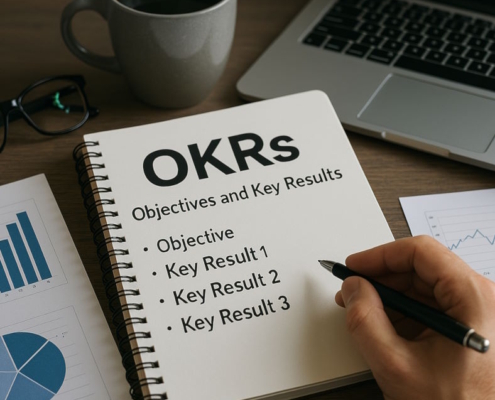What Is Business Communication?
Business communication is exchanging information between employees within the workplace and people outside a company.
Author: Brad Nakase, Attorney
Email | Call (888) 600-8654
Business communication is goal-oriented sharing information between workers and people outside the company to help a business achieve its fundamental goals. In this article, our business attorney in California discusses business communications as follows:
What Does Business Communication Mean?
It is easy to underestimate the importance of business communication because it plays such a normal part in people’s everyday life. The same goes for the business world, where communication plays an understated yet vital part of every business interaction. This is because companies are not mere entities, but collections of real people with personalities and opinions.
A company requires effective business communication to operate successfully. Business communication affects efficiency, processes, management, and every other aspect of running a business.
There are several important things to know about creating and regulating successful business communication.
But first, let’s go over the definition of business communication. Business communication may be defined as the method used to share information between individuals within the workplace and outside it. Successful business communication is when employees and management work together to reach company goals. The goal of business communication is to improve organization and reduce the number of errors made. To achieve a high level of effective business communication, one should work on communication skills and communication processes.
Effective business communication affects different aspects of running a company, including the following:
- Presenting new business ideas
- Making decisions and putting them into practice
- Making plans and proposals
- Reaching agreements
- Successful selling
- Sending and fulfilling orders
- Effective meetings
- Giving feedback to employees and customers
Every kind of organized activity in a company depends on effective business communication and the strategy by which the company relays information. This strategy could be managerial communication or technical communication to vendors or suppliers.
When a business communication process becomes vague or breaks down, a company’s internal systems are at risk of falling apart. Despite the clear importance of effective communication within a business, evidence shows that 60% of internal communications employees do not measure internal communications. Why would this be? It is possible that these professionals simply do not know where to start, or how to take the next steps. They may also not know how to calculate ROI.
Why Is Business Communication Important?
While business communication is important for a number of reasons, it is especially vital when it comes to employee engagement. A string communication strategy is more likely to produce higher employee participation and morale. Companies with connected employees may enjoy increased productivity. Due to a lack of errors and increased understanding between employees, this increase may be as much as 25%.
In fact, companies with engaged employees may also enjoy a 20% increase in operating income over the period of a year. By contrast, companies with lower employee engagement earn more than 30% less.
Clearly, there is a relationship between employee engagement and company success. If we accept that strong business communication results in higher employee engagement, then we can see how important good communication is to a business’ overall performance. But first a business owner must determine a business communication process that works for their company.
What Are the Different Types of Business Communication?
One of the major types of business communication is known as internal business communication. Internal business communication can itself be broken down into three different categories, which are as follows:
- Upward communication: this is any communication that a subordinate delivers to a manager. It is essentially any message going up the organizational hierarchy.
- Downward communication/managerial communication: this is any communication that a superior delivers to a subordinate.
- Lateral communication/technical communication: this is internal or cross-departmental communication that occurs between coworkers.
A second major type of business communication is known as external business communication. External business communication is any kind of messaging that is sent from the office or company to external parties. These parties may be customers, vendors, or any entity that interacts with the company in question.
If we combine these major types of business communication into a spectrum, there are four main types of business communication to explore. These include:
- Receiving assignments and instructions both upward and downward. This includes delegating tasks from one individual to another. Typically, problems in business start due to vague communication in this area.
- Sharing and discussing information about the company, including internal company meetings. Poor communication in this area leads to mistakes or errors in production.
- Giving feedback, correction, and discipline to employees so that they can fix their mistakes and get better at their job. Giving good feedback is a critical part of being a good leader. Part of giving good feedback is having control over body language and non-verbal communication.
- Meetings and discussions related to solving problems and making decisions. Important topics such as these require critical thinking and excellent communication technology to ensure that there are no misunderstandings or errors.
- Public relations can sometimes be considered a form of external communication that is essential to maintaining a good relationship between the company and the public.
How Does Business Communication Differ from Business Communication Services?
Business communication may be defined as the act of communicating within a business. By contrast, business communication services are the types of solutions, often technological, that are used to make communication and teamwork within a business easier.
Business communication services include the following:
- Voice solutions
- Email services
- Video meeting software
- Contact center software that manages contact with customers
- Service tools that allow communication from anywhere
Which Business Communication Services Does a Business Need?
The types of business communication services a business requires depends largely on the size and preferences of the particular company. What works for one company may not work for another. However, for every company, it is wise to only choose software that the business needs and will actually use.
Example: Jesse manages a graphic design company. Interested in improving company communication, Jesse installs a top-quality video conferencing system to hold team meetings. However, he finds that people are reluctant to engage during these meetings, and many do not even turn on their cameras. The feedback seems to be that most people are happy using texting software and are more efficient without time-consuming video meetings. In this case, the video software does not help company communication and only hinders employee engagement. Therefore, it is not a wise investment.
What Kind of Problems Can Business Communication Solve?
It is important for businesses to have clear and effective business communication because it impacts how teams, employees, and managers perform their work and meet their responsibilities. When a business does not have the right communication strategies and tools, people are unable to interact and communicate effectively, which harms efficiency and productivity. For the company, this means unhappy employees and customers, as well as reduced profits.
The ultimate goal of the business communication process is to have a steady, transparent flow of communication. However, there are other, more specific problems that successful business communication solves:
- Too Many Emails
It is a common problem in workplaces that people are completely overwhelmed by the number of messages they receive every day. Believe it or not, the average employee receives 120-150 emails every day. Talk about information overload!
The problem with receiving so many emails is that it is all too easy to forget or overlook a critical piece of information. If a company puts a business communication system in place, it can reduce the number of digital distractions and make room for creativity.
- Horizontal and Vertical Communication
It is common for teams and departments to develop issues exchanging important information. It can be difficult sometimes to get in touch with a department manager when there is an issue within a team that needs to be addressed. These kind of walls come up all too easily, and it can be difficult for people to notice them. However, a proper communication plan can help keep them from forming.
- Poor Communication with Remote Employees
Remote work isn’t going anywhere. Buffer’s State of Remote Work Report has found that most employees want to work remotely for at least part of the time. Although there are certainly benefits to remote work, there are also struggles. Some of these issues include communication and working together. However, these problems can be solved with the right business communication systems in place.
- Low Employee Engagement/Employee Turnover
A business cannot afford to constantly lose its best people. This affects the business’ ability to do its work well, and it is also a big expense. In fact, losing an employee can cost a business about two times their annual salary. Business communication strategies can help prevent a high turnover rate. Companies that communicate well are 50% more likely to have lower turnover rates.
- Bad Customer Service
Poor internal communication within a company can negatively impact customer service. Employees who greet and deal with customers on a daily basis will struggle if they do not have the right information. The bad news for the business is that it is easy for customers to sense when employees’ morale is low. It is all too likely, therefore, that the customers will have a poor experience. The connection has been well-established. A positive employee attitude increases customer satisfaction, which results in an increase in revenue. The reverse is also true.
How Is Non-Verbal Communication Important in Business?
Non-verbal communication is a large category of expression. It includes one’s facial expressions, body language, and even the tone of an email. Most business interactions do not happen in one-on-one interactions or in-person meetings. Instead, they happen through email, task boards, text chats, and more. As is apparent, most business interactions these days are non-verbal. Therefore, it is crucial that people learn how to improve their non-verbal business communication to make sure there are no misunderstandings in their work.
One of the best tips involves reviewing one’s emails or texts. Before sending it, read it aloud. This helps review the message’s tone and catch any awkward or vague phrasing.
How to Set Up a Business Communication Process in Five Easy Steps
The importance of a strong, well-defined business communication process cannot be understated. It effects the satisfaction of one’s employees, and consequently, the financial wellbeing of the company.
And overall, it is clear that many businesses could use improvement in this area. One report found that almost 30% of employees are dissatisfied with their internal communications tools. When asked why, they replied with the following reasons:
- Irrelevant information
- Dishonesty
- Exclusion
- Difficult to access important information
Salesforce conducted a study that found almost 90% of executives and employees claim poor communication is the reason for most workplace problems and inefficiencies. Clearly, communication and teamwork is a critical part of a business’ success, and focus must be placed on how to put together a successful business communication plan.
There are five steps that can be taken to achieve this.
- Review the Current State of Business Communication
Whether a company is just beginning or has been in business for years, it can benefit from the creation of a business communication plan. To be most effective in the short-term, one should focus on the areas that need to most immediate improvement. Other areas can be improved down the line.
How does one know if their business communication is in need of an overhaul? There are some unmistakable signs to be aware of:
- Employee dissatisfaction and high turnover rate
- Low company production
- Information easily misplaced or lost
- Remote work causing lack of information transparency
It is possible for a company to experience one of these problems or many at the same time. There are other negative scenarios as well. The best course is to identify the problem and then design a business communication system based in it. These goals might include the following:
- A lower turnover rate or higher employee satisfaction
- Improvement in customer satisfaction
- More projects completed
- More interaction between departments or teams
- Review How Groups Within a Company Interact with One Another
Before implementing a business communication system, it is helpful to examine the structure of a company and the groups that it consists of. A business owner should be aware of every group and what role it plays in how the company functions. This includes the following categories:
- Horizontal classification: departments (marketing, design, operations, HR, sales, customer support, finances, etc.)
- Vertical classification: team leaders, professionals, department managers, executives
- External groups: customers, partners, suppliers, etc.
After studying the organization of a company, one should consider the work that each department does and the expected production goals. It is necessary to figure out the ways the departments need to communicate in order to meet these goals.
The complexity of setting up a business communication system depends somewhat on the size of the company in question. Therefore, it is a good idea to give oneself plenty of time to consider the issue. Some questions to think about include:
- Which teams talk to each other every day? Which people talk to each other often? How often do they talk?
- What communication happens only in the event of a problem or crisis?
- How do managers and team leaders communicate within their departments to keep productivity up?
- Is there a way to reduce unnecessary meetings and discussions?
- Which projects or activities require approval from others in the company? How are these approvals and requests handled?
The answers to these questions should give one an idea of the necessary amount of business communication that needs to happen within an organization: phone calls, emails, meetings, documents, etc.
- Pick Business Communication Methods
It is important at this stage to decide what methods of business communication will work for one’s company. Again, every company is unique, so there is no one-size-fits-all answer. Much will depend on a business’ communication goals, as well as the particular interactions that occur between individuals and groups in one’s company.
The following are methods of communication that may be helpful depending on one’s situation:
- Web-based communication
- Phone meetings
- In-person meetings
- Video conferences
- Presentations
- Reports and documents
- Forum boards and FAQs
- Surveys
- Customer management activities
Some of these methods may prove essential to one’s company communication while others may not be relevant at all. One should also consider which methods will be optional and which will be mandatory. It is also wise to consider if there will be any pushback against any of these methods. It is important to choose only what is necessary and keep things as simple as possible.
Again, much will depend on the size and nature of the company. A small startup with one office location may only need in-person meetings, online messaging, and customer management. A large company with a lot of remote workers will need entirely different methods, such as phone and video conferencing, as well as a way of organizing and tracking documents.
The largest companies in the world will probably use all of the above methods of business communications, and they will probably have entire teams of people in charge of them.
- Pick the Correct Tools
When it comes to selecting the right business communication tools for one’s business, there is no easy answer regarding which are the best. There are debates about whether to use Gmail or Outlook, Google Drive or Dropbox, Slack or Nextiva. In the end, these are personal choices, and whatever one chooses will serve its purpose well.
There are certain points to remember when selecting business communication tools:
- Use cloud storage to protect important data and documents. Turn on automatic sync and backup to protect information without having to rely on someone manually doing this.
- Use a single platform for calendars and emails
- Use a single chat messaging platform. Having more than one complicates communication.
- Set up a VoIP phone system if the company has a lot of remote meetings.
- Create brand guidelines that establish the tone and voice of company communications. This helps unify communication, creating consistency.
- Record the Process
It is important to write down everything that one does to establish a business communication process. This document should be made available to everyone in the company to view. Employees can refer to it when they need to decide how to communicate in any given scenario. Also, it will be easier for new employees to learn how the company communicates.
If possible, companies should encourage employees to review the document a few times a year to ensure proper business communication. It will also give an opportunity to receive feedback and improve the system as necessary.
What Are Business Communication Channels?
Typically, business communication is either written or verbal. Whether it occurs in-person or remotely, efficient and effective communication is important when it comes to the happiness of one’s employees.
Written communication has a few advantages. It produces a paper trail of actions and decisions, which is helpful when it comes to analyzing past performance. Verbal communication is also a positive because it encourages creativity and openness.
The following are some business communication methods, both written and verbal, that can help improve a business’ communication system.
- Web-Based Communication
Web-based business communication is any written communication that takes place on an online platform. This includes emails and instant messaging, such as Gmail and Slack.
A benefit of this form of business communication is its privacy. In a busy workplace, two or more people can have a conversation without anyone overhearing or interrupting. It is also possible to share messages with many people at once, such as through an email sent to the whole company.
- Telephone Meetings
Phones have the advantage of allowing meetings to take place regardless of location. As compared to written communication, telephone meetings rely more on non-verbal communication, as a person’s tone of voice comes through. Installing a cloud phone system can help make onboarding easier and improve team cooperation.
- Video Conferencing
A video conferencing system is an excellent way to engage remote workers. Employees at remote locations are able to feel as though they are having in-person meetings, even from thousands of miles away. It is a step up from phone meetings.
- In-Person Meetings
Holding meetings face-to-face can be beneficial in that they generate ideas quickly. In fact, studies have shown that in-person meetings are better than virtual meetings at fostering creativity. That said, it is important to have a meeting agenda in place for efficacy. Many employees leave meetings unsure of their instructions. Meetings must therefore have a defined purpose.
- Reports and Official Documents
To have a successful business communication system, it is important to document activities that affect different people and departments. Having well-written documents on hand is helpful when there is confusion or disagreements between departments. This strategy offers extra clarity and can serve as a useful back-up in the event of a crisis.
- Presentations
Presentations, such as those made via PowerPoint, are useful ways of leading large group meetings. They are a great way of staying organized and sharing ideas in a creative space. There is also the space and freedom to ask questions.
- Forum Boards and FAQs
It is wise to host an internal forum for employees to refer to frequently asked questions. These questions should address different departmental subjects. There should also be the ability to ask new questions.
- Surveys
Internal surveys and customer surveys are a great way for a business to get feedback on performance and other important topics. They provide a healthy communication channel between employees and management, as well as between a company and its customers.
- Customer Management Activities
Customer management activities can include live chat support, customer onboarding processes, customer reviews, and customer relationship management systems (CRM).
By using these methods to create a healthy, dynamic communication system, a company will enjoy happy, collaborative employees who are motivated to work toward success.
Have a quick question? We answered nearly 2000 FAQs.
See all blogs: Business | Corporate | Employment Law
Most recent blogs:
Contact our attorney.































